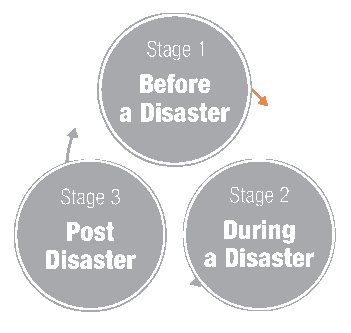

At the conclusion of the previous module, participants should have been introduced to the impact of disasters on cultural heritage and the basic relationships between hazards, vulnerabilities and disaster risks. The disaster risk management cycle has also been introduced to them, illustrating each stage in the disaster risk management process. Building upon this base, participants can now be introduced to the approaches and methods for risk assessment.
Read More...
An excerpt from the timetable of the International Training Course organised by R-DMUCH, 2012 which illustrates how Module 2 can be structured. There is the potential for overlapping content in all three modules which would need to be tailored based on specific needs of the course coordinators and participants and availability of resource persons.
Read More...
At the conclusion of the previous module, participants should have been introduced to the impact of disasters on cultural heritage and the basic relationships between hazards, vulnerabilities and disaster risks. The disaster risk management cycle has also been introduced to them, illustrating each stage in the disaster risk management process. Building upon this base, participants can now be introduced to the approaches and methods for risk assessment.
This module is critical to the course, as it informs participants of the existing methodology and tools for risk assessment that form the basis of the disaster risk management plan. The thematic focus of the course will also determine a large share in this module, since risk assessment can vary widely depending on the scale, location and context of a site and the nature of the hazards under consideration. For instance, a course addressing earthquake risks for a heritage precinct with a large number of timber structures would need to emphasise risk assessment methodology based on seismic characteristics, risks of fire caused due to earthquake as well as the vulnerability of timber and soil conditions in order to determine the behaviour of individual structures. At the level of individual buildings, specific technologies such as behavioural studies of structures could come into play. It is important to introduce this concept to participants who may be professionals involved in the conservation of this type of buildings.
Since each step of the risk assessment process is closely linked, the lectures used to deliver the content could be combined. A single series of workshops or one large exercise could also be used to guide the participants through each stage of the risk assessment process. Secondary case examples are particularly useful for this module as they would help illustrate the detailed approaches and methodology applicable in specific contexts. They may also be used to explain how risk assessment fits within the disaster risk management planning framework.
This module’s content can be summarised for a shorter course but can potentially be an independently taught module for heritage professionals or site managers, especially if it is structured around a specific thematic area. In the International Training Course series organised by R-DMUCH, this module has generally been covered in three or more days out of two weeks and explored specific technical aspects depending on the annual theme of the course.
For shorter courses (TYPE A), this module can be summarised into a single lecture presentation and a workshop as part of a case study. As an independent module of 1-3 days (TYPE B), a series of workshops and case examples could be used to illustrate not just generic approaches to risk assessment but specific focused tools and techniques could also be highlighted.
An excerpt from the timetable of the International Training Course organised by R-DMUCH, 2012 which illustrates how Module 2 can be structured. There is the potential for overlapping content in all three modules which would need to be tailored based on specific needs of the course coordinators and participants and availability of resource persons.
9/10 (Mon) |
9/11 (Tue) |
9/12(Wed) |
Principles, Framework and Risk Analysis at site level |
Risk Analysis at Urban level |
Risk Assessment |
DMUCH |
DMUCH |
DMUCH |
9:30-10:40(70) |
9:30-10:40(70) |
9:30-10:00(30) |
10:00-11:10(70) |
||
Lunch |
||
to Kiyomizu |
To Sannei-zaka |
11:30-12:40(70) |
12:30-15:00(150) |
11:00-12:30(90) |
|
To DMUCH |
Lunch |
|
Lunch |
14:00-15:10(70) |
|
14:00-15:30(90) |
||
To DMUCH |
15:50-17:00(70) |
15:30-17:00(90) |
15:30-17:00(90) |
||
17:00-18:00(60) |
17:00-18:00(60) |
17:00-18:00(60) |
Kyoto |
Kyoto |
Kyoto |